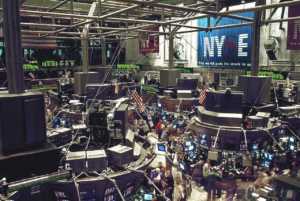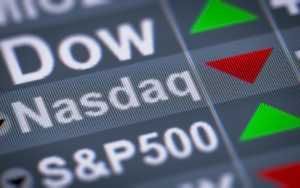What Is The Difference Between A Full-service Broker And A Discount Broker Brainly
What is the Stock Market?
The stock marketplace refers to public markets that exist for issuing, buying, and selling stocks that trade on a stock exchange or over-the-counter. Stocks , also known as equities, stand for fractional ownership in a company, and the stock market is a place where investors can buy and sell ownership of such investible assets . An efficiently operation stock market is considered critical to economical evolution, as information technology gives companies the power to quickly access capital from the public.

Purposes of the Stock Market–Capital and Investment Income
The stock market serves two very important purposes. The starting time is to provide upper-case letter to companies that they tin use to fund and aggrandize their businesses. If a company issues i one thousand thousand shares of stock that initially sell for $ten a share, and then that provides the visitor with $10 1000000 of capital letter that it can use to grow its business (minus whatever fees the visitor pays for an investment banking company to manage the stock offer). Past offering stock shares instead of borrowing the majuscule needed for expansion, the company avoids incurring debt and paying interest charges on that debt.
The secondary purpose the stock market place serves is to give investors – those who buy stocks – the opportunity to share in the profits of publicly-traded companies. Investors tin profit from stock buying in one of two ways. Some stocks pay regular dividends (a given corporeality of coin per share of stock someone owns). The other way investors can profit from buying stocks is by selling their stock for a profit if the stock price increases from their buy price. For example, if an investor buys shares of a company's stock at $10 a share and the price of the stock later on rises to $15 a share, the investor tin can and so realize a 50% profit on their investment by selling their shares.
History of Stock Trading
Although stock trading dates back as far equally the mid-1500s in Antwerp, modernistic stock trading is generally recognized every bit starting with the trading of shares in the East Bharat Company in London.
The Early on Days of Investment Trading
Throughout the 1600s, British, French, and Dutch governments provided charters to a number of companies that included East India in the name. All goods brought back from the Due east were transported by ocean, involving risky trips frequently threatened past severe storms and pirates. To mitigate these risks, ship owners regularly sought out investors to proffer financing collateral for a voyage. In render, investors received a portion of the monetary returns realized if the ship fabricated information technology back successfully, loaded with goods for sale. These are the earliest examples of express liability companies (LLCs), and many held together only long enough for one voyage.
The East India Company
The formation of the East Republic of india Company in London eventually led to a new investment model, with importing companies offering stocks that essentially represented a fractional ownership interest in the company, and that therefore offered investors investment returns on proceeds from all the voyages a company funded, instead of but on a single trip. The new business organization model made it possible for companies to ask for larger investments per share, enabling them to easily increase the size of their shipping fleets. Investing in such companies, which were often protected from competition by royally-issued charters, became very pop due to the fact that investors could potentially realize massive profits on their investments.
The Outset Shares and the First Exchange
Visitor shares were issued on newspaper, enabling investors to merchandise shares back and forth with other investors, only regulated exchanges did non exist until the formation of the London Stock Commutation (LSE) in 1773. Although a significant corporeality of financial turmoil followed the immediate establishment of the LSE, commutation trading overall managed to survive and abound throughout the 1800s.
The Beginnings of the New York Stock Exchange
Enter the New York Stock Exchange (NYSE), established in 1792. Though non the get-go on U.Southward. soil – that award goes to the Philadelphia Stock Exchange (PSE) – the NYSE speedily grew to become the dominant stock exchange in the United States, and somewhen in the globe. The NYSE occupied a physically strategic position, located amidst some of the country's largest banks and companies, non to mention being situated in a major shipping port. The commutation established listing requirements for shares, and rather hefty fees initially, enabling it to quickly become a wealthy institution itself.

Modern Stock Trading – The Irresolute Face of Global Exchanges
Domestically, the NYSE saw meager competition for more two centuries, and its growth was primarily fueled past an ever-growing American economy. The LSE continued to dominate the European market for stock trading, but the NYSE became abode to a continually expanding number of large companies. Other major countries, such equally France and Germany, eventually developed their own stock exchanges, though these were frequently viewed primarily as stepping stones for companies on their way to listing with the LSE or NYSE.
The late twentyth century saw the expansion of stock trading into many other exchanges, including the NASDAQ, which became a favorite dwelling house of burgeoning engineering science companies and gained increased importance during the technology sector nail of the 1980s and 1990s. The NASDAQ emerged equally the first commutation operating between a spider web of computers that electronically executed trades. Electronic trading made the entire procedure of trading more time-efficient and price-efficient. In addition to the rise of the NASDAQ, the NYSE faced increasing competition from stock exchanges in Commonwealth of australia and Hong Kong, the financial center of Asia.
The NYSE eventually merged with Euronext, which was formed in 2000 through the merger of the Brussels, Amsterdam, and Paris exchanges. The NYSE/Euronext merger in 2007 established the outset trans-Atlantic exchange.
How Stocks are Traded – Exchanges and OTC
Most stocks are traded on exchanges such as the New York Stock Exchange (NYSE) or the NASDAQ. Stock exchanges essentially provide the market to facilitate the buying and selling of stocks amongst investors. Stock exchanges are regulated past government agencies, such as the Securities and Exchange Commission (SEC) in the Us, that oversee the market in order to protect investors from financial fraud and to proceed the exchange market operation smoothly.
Although the vast majority of stocks are traded on exchanges, some stocks are traded over-the-counter (OTC), where buyers and sellers of stocks commonly merchandise through a dealer, or "market maker", who specifically deals with the stock. OTC stocks are stocks that practise not see the minimum price or other requirements for being listed on exchanges.
OTC stocks are not subject area to the aforementioned public reporting regulations as stocks listed on exchanges, so it is non equally easy for investors to obtain reliable data on the companies issuing such stocks. Stocks in the OTC market are typically much more thinly traded than exchange-traded stocks, which means that investors ofttimes must deal with big spreads between bid and inquire prices for an OTC stock. In dissimilarity, exchange-traded stocks are much more liquid, with relatively small bid-ask spreads.
Stock Market Players – Investment Banks, Stockbrokers, and Investors
In that location are a number of regular participants in stock market trading.
Investment banks handle the initial public offering (IPO) of stock that occurs when a visitor outset decides to become a publicly-traded visitor past offer stock shares.
Here's an instance of how an IPO works. A visitor that wishes to go public and offer shares approaches an investment bank to human action as the "underwriter" of the visitor'due south initial stock offer. The investment banking concern, after researching the company's total value and taking into consideration what percentage of buying the company wishes to relinquish in the form of stock shares, handles the initial issuing of shares in the marketplace in return for a fee, while guaranteeing the visitor a determined minimum toll per share. It is therefore in the all-time interests of the investment bank to see that all the shares offered are sold and at the highest possible price.
Shares offered in IPOs are near usually purchased by big institutional investors such as pension funds or mutual fund companies.
The IPO market place is known as the main, or initial, market. Once a stock has been issued in the chief marketplace, all trading in the stock thereafter occurs through the stock exchanges in what is known equally the secondary market. The term "secondary marketplace" is a bit misleading, since this is the market where the overwhelming majority of stock trading occurs mean solar day to solar day.
Stockbrokers, who may or may not also be acting as financial advisors, buy and sell stocks for their clients, who may exist either institutional investors or individual retail investors.
Equity inquiry analysts may be employed by stock brokerage firms, mutual fund companies, hedge funds, or investment banks. These are individuals who research publicly-traded companies and attempt to forecast whether a company's stock is likely to rise or fall in cost.
Fund managers or portfolio managers, which includes hedge fund managers, common fund managers, and exchange-traded fund (ETF) managers, are important stock market participants considering they buy and sell big quantities of stocks. If a popular mutual fund decides to invest heavily in a detail stock, that demand for the stock alone is oftentimes significant plenty to drive the stock's price noticeably college.
Stock Marketplace Indexes
The overall performance of the stock market is unremarkably tracked and reflected in the operation of various stock market indexes. Stock indexes are composed of a selection of stocks that is designed to reverberate how stocks are performing overall. Stock market indexes themselves are traded in the form of options and futures contracts, which are also traded on regulated exchanges.
Amidst the fundamental stock market indexes are the Dow Jones Industrial Average (DJIA) , the Standard & Poor'southward 500 Index (S&P 500), the Financial Times Stock Exchange 100 Index (FTSE 100), the Nikkei 225 Index, the NASDAQ Composite Alphabetize, and the Hang Seng Alphabetize.

Bull and Bear Markets, and Short Selling
Two of the basic concepts of stock market place trading are "bull" and "bear" markets. The term balderdash market is used to refer to a stock market in which the price of stocks is generally rising. This is the blazon of market place most investors prosper in, as the bulk of stock investors are buyers, rather than short-sellers, of stocks. A bear market exists when stock prices are overall failing in cost.
Investors tin can withal turn a profit fifty-fifty in bear markets through brusk selling. Short selling is the practice of borrowing stock that the investor does non concur from a brokerage firm that does ain shares of the stock. The investor and so sells the borrowed stock shares in the secondary market and receives the money from the sale of that stock. If the stock toll declines equally the investor hopes, and so the investor can realize a profit past purchasing a sufficient number of shares to return to the broker the number of shares they borrowed at a total price less than what they received for selling shares of the stock earlier at a higher cost.
For example, if an investor believes that the stock of visitor "A" is likely to reject from its current cost of $20 a share, the investor can put downwardly what is known equally a margin deposit in gild to borrow 100 shares of the stock from his broker. He then sells those shares for $20 each, the current toll, which gives him $2,000. If the stock and so falls to $10 a share, the investor tin can then buy 100 shares to return to his banker for only $1,000, leaving him with a $i,000 profit.
Analyzing Stocks – Marketplace Cap, EPS, and Financial Ratios
Stock market analysts and investors may look at a variety of factors to indicate a stock'due south probable futurity direction, up or downwardly in price. Here'due south a rundown on some of the most commonly viewed variables for stock assay.
A stock's market capitalization, or market cap, is the total value of all the outstanding shares of the stock. A higher market place capitalization usually indicates a company that is more well-established and financially audio.
Publicly traded companies are required past substitution regulatory bodies to regularly provide earnings reports. These reports, issued quarterly and annually, are carefully watched by market analysts as a skillful indicator of how well a company'due south business organisation is doing. Among the fundamental factors analyzed from earnings reports are the visitor's earnings per share (EPS), which reflects the company's profits as divided among all of its outstanding shares of stock.
Analysts and investors likewise oft examine a number of fiscal ratios that are intended to point the financial stability, profitability, and growth potential of a publicly-traded visitor. The post-obit are a few of the primal financial ratios that investors and analysts consider:
Cost to Earnings (P/E) Ratio: The ratio of a company'southward stock price in relation to its EPS. A higher P/Eastward ratio indicates that investors are willing to pay college prices per share for the company's stock considering they expect the company to abound and the stock price to rise.
Debt to Equity Ratio: This is a fundamental metric of a company's financial stability, as information technology shows what percentage of a company's operations are being funded by debt compared to what percentage are being funded past equity investors. A lower debt to equity ratio , indicating primary funding from investors, is preferable.
Return on Equity (ROE) Ratio: The render on disinterestedness (ROE) ratio is considered a expert indicator of a visitor's growth potential, as it shows the company'due south cyberspace income relative to the full equity investment in the company.
Profit Margin: There are several profit margin ratios that investors may consider, including operating turn a profit margin and net profit margin . The advantage of looking at turn a profit margin instead of but an absolute dollar profit figure is that it shows what a visitor's percent profitability is. For example, a company may testify a profit of $2 million, but if that just translates to a three% profit margin, then any significant decline in revenues may threaten the visitor'due south profitability.
Other commonly used financial ratios include return on avails (ROA), dividend yield, price to book (P/B) ratio, current ratio , and the inventory turnover ratio .

Two Basic Approaches to Stock Market Investing – Value Investing and Growth Investing
At that place are countless methods of stock picking that analysts and investors employ, but virtually all of them are one form or another of the 2 basic stock buying strategies of value investing or growth investing.
Value investors typically invest in well-established companies that have shown steady profitability over a long period of time and may offer regular dividend income. Value investing is more focused on avoiding risk than growth investing is, although value investors do seek to buy stocks when they consider the stock toll to be an undervalued bargain.
Growth investors seek out companies with exceptionally high growth potential, hoping to realize maximum appreciation in share cost. They are usually less concerned with dividend income and are more willing to risk investing in relatively young companies. Technology stocks, because of their high growth potential, are often favored by growth investors.
Additional Resources
Thank you for reading CFI's guide on Stock Marketplace. To continue learning and developing your knowledge of financial analysis, nosotros highly recommend the additional CFI resources below:
- Types of Markets – Dealers, Brokers, Exchanges
- Trading Mechanisms
- Investing: A Beginner's Guide
- Stock Investment Strategies
What Is The Difference Between A Full-service Broker And A Discount Broker Brainly,
Source: https://corporatefinanceinstitute.com/resources/knowledge/trading-investing/stock-market/
Posted by: mccoymazintim.blogspot.com


0 Response to "What Is The Difference Between A Full-service Broker And A Discount Broker Brainly"
Post a Comment